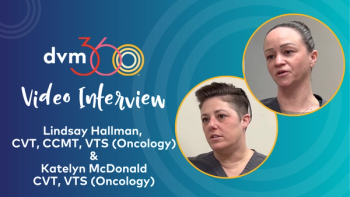
Keep listening but start watching your veterinary clients
Clients' body language can often reveal what they're really thinking. Here's how to read between the lines.
Recently, I had a training session with my staff about the unspoken word. It started when I watched a discharge take place at the front desk. The client had already met with the technician in the exam room and was now at the front desk paying for the services. The client service team member reviewed the services that were checked off on the travel sheet against those on the invoice. She didn't miss anything or say anything wrong.
In the middle of this process, the client answered her cellphone. Now, at first I thought she was just being rude and so did my client service team member, but as I continued to watch I could see her body language and hear her words-this gave me some clues about what was up. After the client was finished and left, I pulled the client service team member aside and asked for her take on what had just happened. She gave me the play by-play, not knowing I had been watching, and her version was that everything was fine except the client was rude and took a call right in the middle of her transaction.
I asked the team member if she thought the client was frustrated or upset about her bill or the visit. The team member told me no. Next, I gave her my version of what I witnessed. I asked her if she noticed that the client never looked her in the eye, even before the cellphone rang. She hadn't noticed. The client looked down, around at other clients in the reception area, team members walking by and her dog pulling at the leash and her arm. I noticed that. I asked the client service person if all the client's questions were answered during this visit. She said that they had been. The reality? Maybe not since the client service member never asked her, even though our protocol states she should ask.
My next step was to call Mrs. Jones. I explained that I was calling to ask about her experience at our practice today. Mrs. Jones was friendly and told me she left our practice a bit frustrated. It seems that she brought her dog, Spike, in with a complaint of “shaking her head.” I asked her if she was willing to share with me the reasons for her frustrations. Here they are:
- Spike, though a masculine name, was a girl. Client frustration? Every team member, veterinarian included, who interacted with Spike on this day called Spike a “he.”
- Spike shaking her head didn't seem like a $150 visit to the client. It was in fact a $150 bill, although Mrs. Jones felt that was a bit high. I asked her what the doctor did today and she told me this: “He didn't do much. He looked in her ears and said something about yeast and bacteria, some test EDA, and some coccidia thing.” Let me backtrack here and tell you that most often when a client is frustrated with a bill, I find the client didn't see the value in what we did. That's not the client's problem-it's ours! And this was the case here.
I talked to the doctor and looked at his travel sheet: a full physical examination. He checked Spike over head to toe but since he didn't verbalize each step, Mrs. Jones didn't know he did it. Her view? “He petted Spike.” He sure did but that was really him petting Spike to check for lumps and bumps. He petted Spike while he listened to her heart. Yes, he did look in the ears and that EDA was really an EDA. Also, we didn't speak in terms the client understood. Mrs. Jones didn't know what an EDA was. She was actually quite interested once I took the time to explain it to her. And of all those things the doctor found. It wasn't coccidia, it was cocci. Yes, there was yeast and bacteria but that wasn't explained to Mrs. Jones. Nobody told her the differences and that different ear medications treat different things so she just thought we jacked up her invoice by adding a “ton of medications.”
Ear appointments are a frequent item of contention at our practice. The client thinks it's a simple thing that requires at best, a simple, single medication. Our doctors know differently. They most often run the EDA, they frequently use the video vetscope to see inside the ear canal, and there are often a few different medications. We had a plan in place for just this situation, but we didn't use it. We didn't show her the ear canal on the vetscope screen. We didn't print her photos. We didn't give her the handout about the ear canal, how to administer medications, and what an ear infection is.
At discharge she was angry and we rattled off, once again, all those things she just heard but didn't understand which only frustrated her more. She responded with no eye contact, a cellphone call and many sighs. We had a chance to fix this by asking if she had any questions or if she understood everything that took place in her visit today, but we didn't.
So, do you see what happened here? We missed the nonverbal cues that were screaming at us that we dropped the ball and Mrs. Jones was going to leave and maybe never come back. She certainly wasn't coming back for the recommended medical progress exam in two weeks. People often tell you they're fine when most certainly everything about them is screaming at you that they're not fine. Read those cues and act on them. Fix the issues, or you risk losing your clients.
Mrs. Jones is now happy. She asked me how I knew something was wrong. I told her about all the nonverbal cues I witnessed. She chuckled and told me how perceptive I was. Then she said she was also good at reading them and at that point she could tell I was smiling while I was talking on the phone with her. Of course I was! That's rule No. 1 one of answering the phone at my practice.
Newsletter
From exam room tips to practice management insights, get trusted veterinary news delivered straight to your inbox—subscribe to dvm360.




